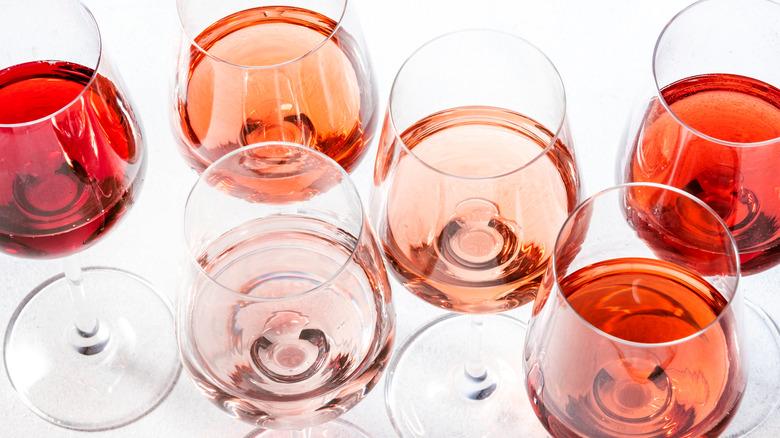The Mistake You're Making When Ordering Rosé By Its Color
As we approach summer sipping season, let's make one thing perfectly clear: You can't judge a rosé by its color. Despite evidence to the contrary, it's a common misconception that pastel-pink rosé is dry while ruby-hued rosé is sweet. There's so much more to the nuanced tones of rosé than meets the eye. It's difficult to pin down exactly why the misleading color-coded assumptions are so prevalent among wine lovers, but theories abound.
One theory suggests that rosé is often confused with blush varietals like rose-toned white zinfandel, which, although diverse, tend toward the sweeter side, prompting tasting notes with descriptors like cotton candy, melon, jammy, and fruity. Adding to the confusion, some segments of the California wine-making industry are embracing "blush" as a blanket term for all pink wines, including authentic rosé. And then there's this: Blush wines can be blended, mixing red and white varietals, to create a pink-ish tone, but rosé is never blended. So, while all rosé wines are blush wines, not all blushes are rosés.
In the eye of the beholder
To really understand rosé, we have to cut through the peripheral associations with blush wine in general and focus solely on authentic rosé, how it's made, and what accounts for its spectrum of lovely pink hues. So let's get to it. When it comes to rosé — from the palest pink to the richest ruby — color has absolutely nothing to do with sweetness. Let that sink in. Color is completely and totally a result of the maceration process, aka the time a vintner allows the red grape skins (rosé is always made from red grapes) and their juices to mingle after crushing. The longer they linger, the darker the color.
There is, however, a caveat. Darker rosés, the varieties that macerate longer, absorb more tannins. Naturally occurring organic compounds, tannins account for textural qualities wine enthusiasts describe as velvety or full-bodied but definitely not sweet. Need more convincing? Consider this. According to the Wine International Association, darker roses are generally more popular than light roses, but in blind tastings where the color of rosé is concealed, consumers tend to favor paler shades.

